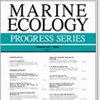Trophic ecology of Carolina Sphyrna gilberti and scalloped S. lewini hammerheads in the southeastern USA
IF 2.1
3区 环境科学与生态学
Q2 ECOLOGY
引用次数: 0
Abstract
ABSTRACT: Carolina hammerheads Sphyrna gilberti and scalloped hammerheads S. lewini are cryptic species with an overlapping distribution, and young-of-the-year (YOY) use similar coastal and estuarine nursery areas along the US Southeast coast. The diet of scalloped hammerheads has been widely studied throughout their global distribution; however, little is known about their diet in the western North Atlantic Ocean. Carolina hammerheads have only been recently described, and as such, their trophic ecology is largely unstudied. Stomach content analysis of genetically identified YOY Carolina and scalloped hammerheads revealed both species to be generalist feeders with diverse diets and no apparent resource partitioning between them. By contrast, multi-tissue (muscle and plasma) stable isotope analyses showed significant interspecific differences in signatures, particularly in muscle δ13C values for the youngest hammerheads. Due to slow tissue turnover rates, YOY muscle signatures were assumed to reflect maternal isotopic signatures, suggesting habitat or resource partitioning between mature female Carolina and scalloped hammerheads. In particular, the data are consistent with mature Carolina hammerheads inhabiting more offshore waters or consuming a higher proportion of pelagic prey relative to scalloped hammerheads. YOY muscle and plasma δ15N values decreased drastically across the sampling season, reflecting a loss of the maternal signal as the YOY hammerheads fed and grew rapidly in these productive nursery habitats.美国东南部卡罗莱纳锤头鲨(Sphyrna gilberti)和扇贝锤头鲨(S. lewini)的营养生态学
摘要:卡罗莱纳锤头鲨(Sphyrna gilberti)和扇叶锤头鲨(S. lewini)是分布区重叠的隐蔽物种,年幼锤头鲨(YOY)在美国东南沿海使用类似的沿海和河口育苗区。扇贝锤头鱼的食性在其全球分布范围内已被广泛研究,但对其在北大西洋西部的食性却知之甚少。卡罗莱纳双髻鲨最近才被描述出来,因此它们的营养生态学在很大程度上还未被研究。对经基因鉴定的卡罗莱纳双髻鲨和扇贝双髻鲨幼鱼的胃内容物分析表明,这两种双髻鲨都是食性多样的通食动物,它们之间没有明显的资源分配。与此相反,多组织(肌肉和血浆)稳定同位素分析显示出显著的种间特征差异,尤其是最年轻的双髻鲨的肌肉δ13C值。由于组织更替速度较慢,因此假定年幼双髻鲨的肌肉特征反映了母体同位素特征,这表明成熟雌性卡罗莱纳双髻鲨和扇贝双髻鲨之间存在生境或资源分配。特别是,这些数据与成熟的卡罗莱纳双髻鲨栖息在更近海的水域或相对于扇贝双髻鲨摄食更高比例的浮游猎物相一致。稚鱼肌肉和血浆中的δ15N值在整个采样季节急剧下降,这反映出随着稚鱼在这些富饶的育苗栖息地中快速觅食和生长,母体信号也随之消失。
本文章由计算机程序翻译,如有差异,请以英文原文为准。
求助全文
约1分钟内获得全文
求助全文
来源期刊

Marine Ecology Progress Series
环境科学-海洋学
CiteScore
5.30
自引率
8.00%
发文量
238
审稿时长
3 months
期刊介绍:
The leading journal in its field, MEPS covers all aspects of marine ecology, fundamental and applied. Topics covered include microbiology, botany, zoology, ecosystem research, biological oceanography, ecological aspects of fisheries and aquaculture, pollution, environmental protection, conservation, and resource management.
 求助内容:
求助内容: 应助结果提醒方式:
应助结果提醒方式:


